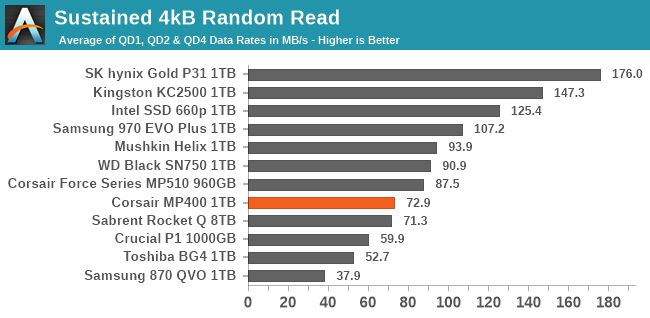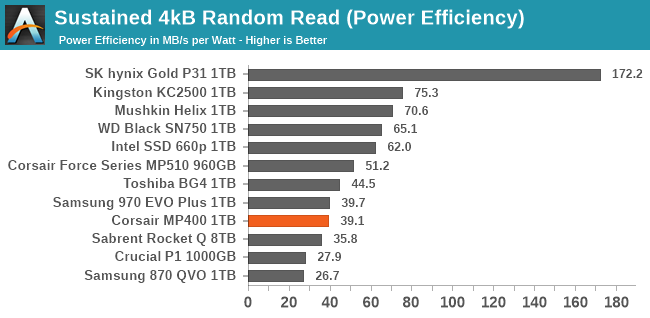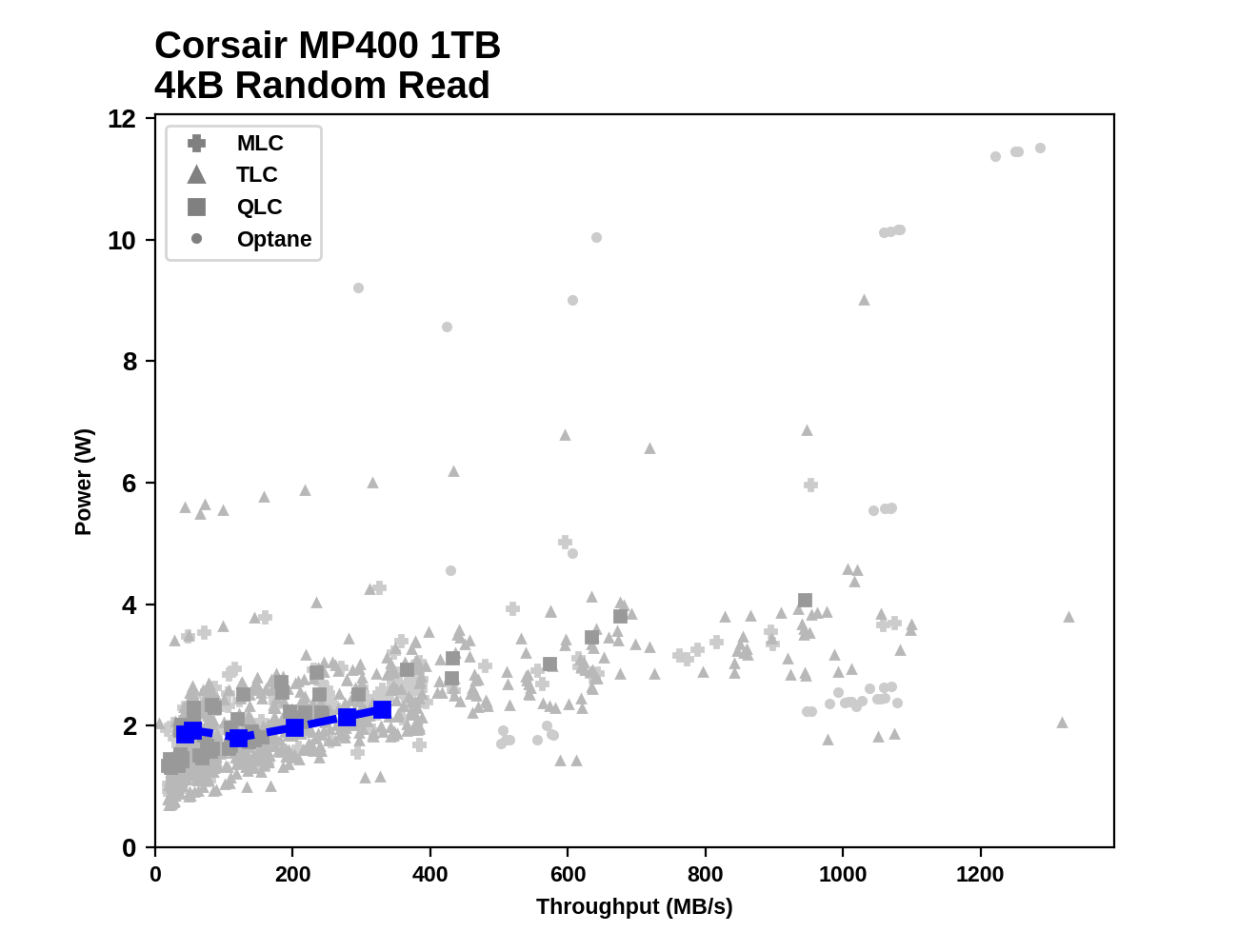The Corsair MP400 1TB QLC NVMe SSD: A Quick Review
by Billy Tallis on December 11, 2020 2:00 PM ESTBurst IO Performance
Our burst IO tests run at a queue depth of one and the amount of data transferred is limited to ensure that SLC write buffers don't fill up and controllers don't overheat. In between each burst there's enough idle time to keep the drive averaging a 20% duty cycle, allowing for some buffered writes and deferred garbage collection to be completed. The random read and write tests use 4kB operations and the sequential tests use 128kB operations. All the burst tests are confined to a 16GB portion of the drive, so DRAMless SSDs are not disadvantaged as much as they are for larger tests.
 |
|||||||||
| Random Read | Random Write | ||||||||
| Sequential Read | Sequential Write | ||||||||
The aggressive SLC caching strategy used by the Corsair MP400 and most other QLC NVMe SSDs allows them to provide best-case random IO performance that is competitive with many high-end PCIe 3.0 drives. However, despite the 8-channel controller, the burst sequential IO performance of the Corsiar MP400 is still fairly low by NVMe standards. The Sabrent Rocket Q 8TB's results indicate that at least some of the higher-capacity MP400 models should also be able to provide better burst sequential write speeds by virtue of having larger and faster SLC caches.
Sustained IO Performance
Our sustained IO tests measure performance on queue depths up to 32, but the scores reported here are only the averages for the low queue depths (1,2,4) that are most representative of real-world consumer workloads. Each queue depth is tested for up to one minute or 32GB, and the tests are confined to a 64GB span of the drive.
 |
|||||||||
| Random Read | Random Write | ||||||||
| Sequential Read | Sequential Write | ||||||||
On the longer synthetic IO tests, the Corsair MP400's best results are for random writes, where its SLC cache is sufficient to keep it competitive against high-end PCIe 3 drives. The sequential write and random read performance scores are both constrained to the entry-level NVMe performance ranges, but are competitive for that market segment. The sequential read performance is relatively poor even for entry-level NVMe drives, though still significantly better than Samsung's QLC SATA alternative.
 |
|||||||||
| Random Read | Random Write | ||||||||
| Sequential Read | Sequential Write | ||||||||
With QLC NAND and an aging 8-channel controller, it's no surprise that the Corsair MP400's power efficiency scores are generally unimpressive, especially compared to what the 4-channel NVMe drives score when they are performing well. However, the only particularly poor efficiency score from the MP400 is for the sequential read test that it did not perform well on.
 |
|||||||||
| Random Read | Random Write | ||||||||
| Sequential Read | Sequential Write | ||||||||
Plotting power and performance against our entire library of benchmark results shows that—for better or for worse—the Corsair MP400 doesn't stand out from the crowd or break new ground. The random read performance stays entirely within the range of SATA drives. Random and sequential writes make some use of PCIe performance, but don't come close to saturating the PCIe 3 x4 interface. The sequential read performance does almost make it to 3GB/s at higher queue depths, but it isn't able to fully saturate the PCIe interface the way the 8TB Sabrent Rocket Q can.
 |
|||||||||
| Random Read | |||||||||
| Random Write | |||||||||
| Sequential Read | |||||||||
| Sequential Write | |||||||||
Digging into how performance and power scale with increasing queue depths reveals no particular surprises for the Corsair MP400. The biggest discrepancies with the 8TB Sabrent Rocket Q are for random reads and sequential writes: more flash allows the 8TB drive to continue scaling up random read performance after the 1TB MP400 is starting to reach saturation, and the larger SLC cache for the 8TB drive allows higher and more consistent sequential write performance.










75 Comments
View All Comments
DZor - Friday, December 11, 2020 - link
Today's drives have less and less endurance.This Corsair 1TB model just 200TBW
For example Samsung 860 EVO is 600TBW!!!! Three times longer!!!
rozquilla - Friday, December 11, 2020 - link
Agree, it is an almost disposable storage device. On the other hand an average office/web user will not reach this level of writes for years, but somebody using NVMe drives in RAID for content creation will need to have like an ammo box of these drives nearby to keep swapping drives.Tomatotech - Friday, December 11, 2020 - link
Maybe, maybe this type of drive, at this price point, isn't aimed at 'content creators'. Anyone earning a living off content creating is going to be using rather more expensive tools. Looks perfectly fine for the average user.In the recent Anandtech review of the QLC 8TB nvme drive, I was really quite impressed the way the 8TB drive leveraged its vast storage space to overcome many of the QLC limitations. It was able to use up to 2TB as high speed SLC-level cache. Many people will rarely move more than 1 or 2 TB in a single operation.
Looking forward to 8TB QLC+ drives dropping to mortal prices.
danbob999 - Monday, December 14, 2020 - link
The thing is, is that drive is 7 TB full, you don't get that same 2 TB cache. There is likely at most 256 GB left.TheinsanegamerN - Tuesday, December 15, 2020 - link
And how many users are going to move 256GB at once?at_clucks - Wednesday, December 16, 2020 - link
You're asking the wrong question. What happens when you have a full drive (like most regular users end up doing because data tends to cruft up in there), and now you juggle all your operations in the little space you have free? Sure, wear leveling you might say but again, in an SSD with sub-mediocre performance AND endurance that will not go well because that's a lot of data you move around to do wear leveling. Keep in mind that wear leveling isn't about getting lower total wear but rather getting uniform wear and spread out concentration of write cycles (it actually increases wear by write amplification). Eventually the drive, depending on how its WL algorithms work, will start moving the long stationary data around to the blocks that were used more, in order to write the more dynamic data to those "pristine" blocks. *All* of that data has to be constantly shuffled for the WL to work as expected. That's how WL and garbage collection work and it's great when you have a lot of free space and basically treat it as a small drive with 7TB to spare to make up for shitty QLC.You can't get something from nothing, having a lot of space makes the issue "less obvious" to the user, not "non-existent", and only if it's free. The issue is still there. The free space kept free is the price you pay for having a working drive. Like a CPU with 32 cores but you can never use more than 12 because they will out.
Maverick009 - Friday, December 11, 2020 - link
Even content creators do not have to worry as much, plus the serious ones still use Mechanical Hard drives, but usually the NAS quality ones like the IronWolf/Pro drives due to storage space per cost still being greatly cheaper. The SSD will be mainly used for the OS and applications to launch from, with a few using an SSD as a scrub drive, or RAID several mechanical drives together and use an SSD as a cache drive between them moving data much faster, while having also having the benefits of large storage.Beaver M. - Saturday, December 12, 2020 - link
No. You need a fast SSD when editing. A HDD is only useful for archiving anymore.niva - Wednesday, December 16, 2020 - link
Seriously, did you even read his comment?Beaver M. - Friday, December 18, 2020 - link
What? Youre acting as if what he claimed is any proof.